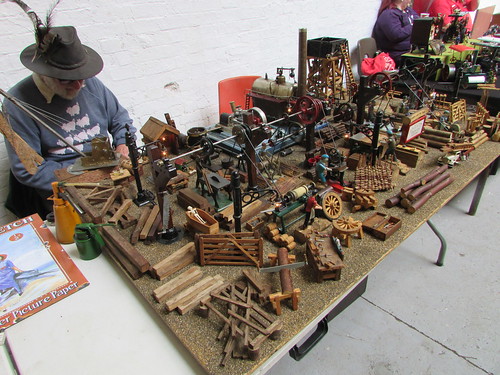The 3rd and 4th June was the Model Steam Weekend. I wasn't originally rostered since I'd been driver at Shackerstone on the previous Monday 29th May (described here) and I'd also driven at Peak Rail on Wednesday 31st May. However, when I heard that Adrian L. wanted to 'split' his shift, I agreed to help and, to my surprise, Adrian chose to do 'early', allowing me to leave home at the unheard-of time of 10 a.m. rather than the usual 5.30 a.m. I thought this would give me a chance to look at the steam models on display before relieving Adrian on 'Cumbria'.
So I joined the first train leaving Shackerstone at 11.15 a.m. "on the cushions" (although I was actually in the Guard's 'BG' at the head of the train, leaning out of the window). We were soon making our stop at Market Bosworth, where I left the train and watched it disappear towards Shenton.

'Cumbria' heads out of Market Bosworth with the 11:27 to Shenton.
Market Bosworth station is a much livelier place these days, with Station Staff to welcome passengers.

Battlefield Line Model Steam Weekend, 2017: Smartly-dressed
station staff welcome passengers.
Usually, Dave P. staffs the Ticket Office. Market Bosworth has an impressive range of tickets on sale.

Battlefield Line Model Steam Weekend, 2017: Dave P. in the
Ticket Office at Market Bosworth.
The line through Market Bosworth was built by the Ashby and Nuneaton Joint Railway, a collaboration between the London and North Western Railway and the Midland Railway. They provided Market Bosworth with a substantial, attractive brick Goods Shed which is now used by the Battlefield Line for exhibitions and special functions.

Market Bosworth Goods Shed.
To reach the Goods Shed, I crossed the line by the gated foot crossing at the south end of the station.

Market Bosworth View from foot crossing looking towards Shackerstone showing the station and work in progress on the new passing loop.
The right hand side of the Goods Shed was lined with an array of exhibitors showing live steam models.

Miniature Steam Models at the Battlefield Line.
These were mainly proprietary models of stationary engines either British 'Mamod' or German 'Wilesco', although some exhibits had elaborately detailed scale workshops added.

A large model of a timber yard with various machines driven by overhead shafting from a working steam engine.
'Dave's Toy Steam' showed an extensive range of models and you can find out more at the website here. There's a global forum, started in 2006, for this type of enthusiast called 'The Unofficial Mamod and Other Steam Forum'.
A large 'O' gauge coarse-scale model railway layout was on display. I understand that it was built some years ago by an R.A.F. model railway society before passing into private ownership. It's a 'modular' layout and sections can be assembled in various arrangements, to suit the venue. The layout is now in need of some 'T.L.C.' but the operators ran an '08' (at scale speed, I was pleased to see) on a short freight train round the continuous single line oval whilst I was there. Unfortunately, after a few circuits, the wagons decided that rather than dutifully following the locomotive around a check-railed curve, they would try a 'short-cut' and in the process tumbled down the model embankment, still connected together by the 3-link couplings. I was reminded of the 'Prototype for Everything' feature which used to run in the model railway press and remembered a similar accident I witnessed on the 'big railway' at Wolverhampton which I mentioned, briefly, in the post Wolverhampton High Level Station in Steam Days.

'0' gauge coarse scale modular model railway:The freight train passes through a landscaped area of the layout.
There was an attractive refreshment area in the Goods Shed, so I had an early sandwich lunch before returning to Market Bosworth station to catch the second service from Shenton back to Shackerstone. At Shackerstone, I relieved Adrian and drove the last three round trips to Shenton with 'Cumbria'.
My pictures
Battlefield Line Model Steam Weekend, 2017.
Miniature Steam Models at the Battlefield Line.
'0' gauge coarse scale modular model railway.





